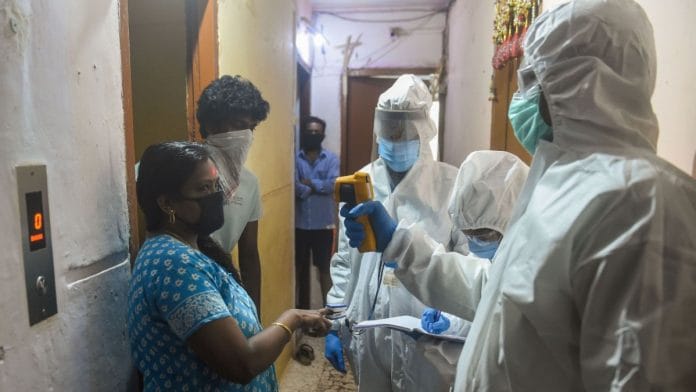Mumbai: The spread of the novel coronavirus in Mumbai’s slums seems to have abated, while the infection is on the rise in the city’s non-slum areas, the second serological survey conducted by the Brihanmumbai Municipal Corporation (BMC) has found.
The survey, conducted last month and released Thursday, included 5,384 participants chosen through random sampling from three of the city’s 24 administrative wards — R North (Dahisar), M West (Chembur) and F North (Sion-Matunga).
The survey excluded people in the civic body’s institutional quarantine facilities and containment zones.
In slums, 45 per cent people were found to have Covid antibodies in the second serological survey as compared with 57 per cent in the first survey.
The second survey stated 18 per cent seroprevalence in those living in Mumbai’s buildings as compared with 16 per cent in the first round.
The first serological survey was conducted in July and involved 6,936 participants. Both surveys were commissioned by the BMC along with NITI Aayog and the Tata Institute of Forensic Research.
Suresh Kakani, additional municipal commissioner, BMC, told ThePrint: “The results show that the BMC’s approach of proactively identifying high-risk contacts in slums and isolating them in institutional facilities seems to be helping in reducing the spread in slums.”
Kakani also said the spread in non-slum areas at the moment may be more than what the results of the second serological survey suggest.
“There is just a marginal increase in those from buildings and high rises (who were) found to have antibodies as compared with the first survey because the second survey was conducted when we had just started witnessing a spike in cases from high-rises. As such, cases from buildings and high rises started increasing after the Ganpati festival. It takes 14 to 28 days for the antibodies to build up,” he added.
The 10-day Ganpati festival concluded on 2 September after which Mumbai saw a sudden surge in the number of Covid-positive cases as testing had also aggressively increased.
As of Thursday, Mumbai has recorded a total of 2,07,494 Covid-positive cases of which 27,435 are active. So far, 8,969 people have succumbed to the infection.
Also read: Pune’s first sero survey shows over 51% infected by Covid in 5 high-incidence areas
Masks, social distancing, basic hygiene helping
Seroprevalence in healthcare workers working in slum areas was found to be much lower than those living in the slums.
Among healthcare workers employed at civic health posts, dispensaries, civic health offices and among programme field staff, seroprevalence found in both the rounds of the survey was an average of 27 per cent.
Kakani said: “Healthcare workers used the necessary protective gear such as face masks, face shields, observed social distancing and took precautions about hygiene such as washing and sanitising hands often. So, a major takeaway of the sero survey is that these precautions are found to be effective in containing the spread of Covid.”
“As we unlock and open more activities in the city, it is important for the general population to take these precautions to keep the virus in check,” he added.
No indication of herd immunity
While the first round of Mumbai’s serological survey did not conclusively say anything about herd immunity, it had indicated that at least in slums it could be attained sooner than later.
The second round of the serological survey provides no further indication of possible herd immunity.
Kakani said: “We can’t even say we are headed in the direction of herd immunity.”
The BMC’s press statement said: “Emerging scientific evidence hints at fall of antibody levels in recovered patients/asymptomatic patients over a period of time and might have contributed to the trend between the two rounds of sero survey. The impact of this on immunity, if any, is still unknown.”
Like in the first survey, the seroprevalence among women was marginally higher than men. However, unlike the first round when seroprevalence was uniform across all age groups, the second survey showed higher seroprevalence among those older than 40 years.
Also read: Mumbai serological survey results show its slums could be reaching herd immunity for Covid







Non slums people who pay exorbitant taxes don’t matter as they are very few and hence don’t matter much as a votebank, for media as well they don’t matter as only non tax paying populace generate byte worthy attention. So yes, all health infra for dharavi and rest of the populace can fend for themselves.
May slums in Mumbai grow leaps and bounds.